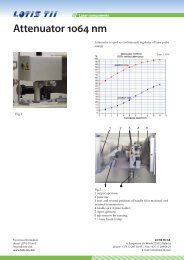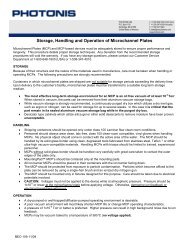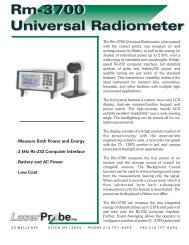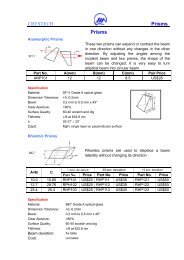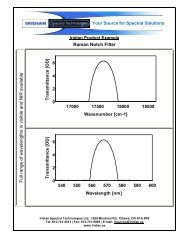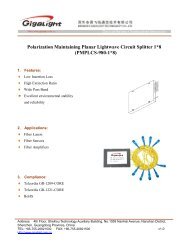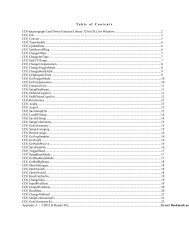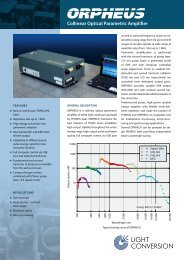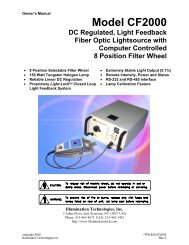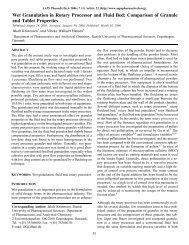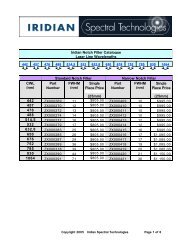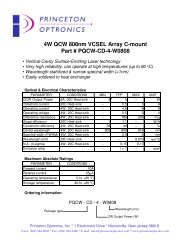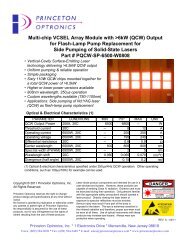Create successful ePaper yourself
Turn your PDF publications into a flip-book with our unique Google optimized e-Paper software.
User’s <strong>Manual</strong><strong>DAGE</strong>-<strong>MTI</strong>Excel SeriesCCD Digital Cameras& Exponent Software
Table of ContentsPAGE3 Purchaser’s Record4 Introduction6 Installation6 Hardware Requirements7 IEEE-1394 Card Installation (PC)8 Exponent Application & Driver Uninstall8 Exponent Application & Driver Installation13 Automatic Camera Driver Installation15 Operation15 Overview16 Menu Bar16 Camera17 View\Display Mode17 View\Image Interpolation17 View\Bayer Algorithm18 View\Timestamp18 View\Saturated Pixels19 View\Toolbox Windows19 Tools\Options19 Pause when in Background19 Tools\Maintenance19 Help\About19 Help\User’s <strong>Manual</strong>19 Video Window19 Status Bar19 Trigger Mode19 Integration Time19 Frames per Second19 Gain19 Color Gain20 Camera Controls via Toolbars and Toolbox20 Camera Toolbar20 Start20 Pause20 Stop20 Disconnect20 Camera Memory Presets Toolbar20 TWAIN Interface Toolbar21 Image Capture21 Image Capture w/Filename Dialog21 Autosave Toolbox21 Enable21 Filename21 Format22 Source22 Timelapse Setup23 Format Toolbar/Toolbox23 Binning2
Table of ContentsPAGE23 Region of Interest23 Pixel Depth24 Exposure Toolbar/Toolbox24 Exposure24 Gain24 Shutter25 Extended Integration Threshold25 Color Toolbar/Toolbox25 <strong>Manual</strong>25 One Push25 Auto26 Histogram Toolbox26 Performance Toolbox27 Trigger Toolbox29 Strobe Toolbox29 Miscellaneous Toolbox30 Auxiliary Connector31 Back Focus Adjustment31 Software Development Kit (SDK)32 Troubleshooting33 Specifications34 Excel Camera Spectral Response34 Excel Camera Quantum Efficiency35 Excel Camera Mechanical Features36 Warranty37 Appendix-A IEEE-1394 Laptop Installation39 Appendix-B Windows “Found new Hardware Wizard” Driver Install Method41 Appendix-C <strong>Manual</strong> Camera Driver Installation46 Appendix-D Updating Camera FirmwarePurchaser’s RecordModel Name: □XLVM □XLVC □XL16MSerial Number:Dealer’s Name:Dealer’s Address:Dealer’s Phone Number:Date Purchased:P.O. Number:□XL16C □XLMM □XLMC3
IntroductionExcel Camera HardwareThe <strong>DAGE</strong>-<strong>MTI</strong> Excel family of digital cameras are based upon the Kodak KAI series ofinterline transfer, progressive scan, CCD sensors. These high performance sensors have7.4um square pixels with microlenses to provide high sensitivity and the large full wellcapacity results in high dynamic range. The XLV camera has 640x480 pixels (VGA) @ up to75 frames per second. The XL16 camera has 1600x1200 (UXGA) pixels @ up to 16 framesper second and the XLM camera has 2048x2048 pixels @ up to 7.2 frames per second. Allmodels are available with color or monochrome sensors.The Excel cameras operate over an IEEE-1394 Firewire bus. For simplistic operation,all that is required for operation is a single IEEE-1394 cable connection between the cameraand the PC. An IEEE-1394 PC card and cable are provided with each camera. OptionalIEEE-1394 PCMCIA adaptors and cables are available for use with Laptops.The Excel cameras are IIDC version 1.31 compliant set forth by the 1394 TradeAssociation. Having the cameras adhere to a defined set of guidelines ensures easierintegration and consistency for software interface and development. This also allows thecameras to be controlled by 3 rd party software designed to control IIDC compliant devices.Full automatic and manual shuttering, gain and extended exposure modes allow forexceptional image results even under difficult lighting conditions. Binning is available in colorand monochrome versions to provide increased sensitivity and frame rates for dynamicimages. A scalable ROI (Region Of Interest) feature allows viewing and saving of portions ofthe image area needed. This also allows faster frame rates for dynamic images and smallersaved file sizes.An Auxiliary connector provides an external trigger input and a strobe output for triggeredcapture to external events. Two General Purpose In/Out (GPIO) pins are also provided forvarious features such as a Footswitch capture control.The camera mounts to the industry standard C-Mount optics. This allows connection toMicroscopes with C-Mount ports as well as C-Mount lenses. A Nikon F-mount adapter isavailable for adapting the camera lens mount to accept Nikon F lenses.4
Exponent Camera SoftwareExponent, a powerful yet easy to use software application, is provided to operate theExcel cameras. This software provides a user friendly approach to set up and operate all thefeatures of the camera. Toolbars provide access to commonly used camera functions whileallowing the video display window to have maximum display area. The ToolBox area allowsprecise control of available camera features and options all laid out in a logical, easy to usemenu structure keeping all adjustments handy without having to hunt through menus. Thesoftware uses state of the art graphic design for an informative and clean appearance whichtakes advantage of the “XP” look and feel that everyone is familiar with. Multiple camerascan be used either independently or simultaneously with each having its own softwarewindow and set of controls. This allows the user full control to view the video, makeadjustments and decide which camera is active without having those annoying floatingadjustment menus or confusion as to which menu operates each camera.Three image viewing options are available. The image can be displayed mapping thesensor pixels 1:1 with the monitors’ displayed pixels or fit the whole sensors’ field of view tothe display window or fit the sensors’ field of view to the monitors’ “Full Screen” view.Camera memory presets allow the user to recall up to 15 sets of camera adjustmentsplus a factory default. These presets remain in the camera memory so the camera canswitch locations and the stored presets can still be used.A status bar indicates current pertinent information such as the displayed frame rate,integration time, gain and trigger status.Either the Image Capture button, TimeLapse acquisition, external Trigger or a GeneralPurpose Input can be set to operate the Auto Save feature. This allows images to beautomatically named, numbered and placed into a user specified folder. In addition tocapturing special events a footswitch can be used to view and capture live images whilekeeping both hands free to operate a microscope or other piece of equipment. This can savevaluable time over having to click a capture, key in a name, and then finally save an image.Camera Firmware and Drivers can all be loaded from the Tools menu. This insures theuser can update newly released camera features without downtime due to sendingequipment back to the factory.A TWAIN driver is included which allows Exponent to import images into your favoriteapplications.The <strong>DAGE</strong>-<strong>MTI</strong> Excel family of cameras and Exponent software provide a highperformance, easy to use and versatile solution to Digital Imaging.System Contents:• Excel series Camera• IEEE-1394 PC Card• IEEE-1394 Cable• Exponent Software• Twain Driver• BackFocus Wrench• User’s <strong>Manual</strong>Options:• IEEE-1394 PCMCIA Card & P/S kitP/N: 207744-03 (Laptops w/o 1394 port)• 4-6 Pin IEEE-1394 Cable & P/S KitP/N:207744-04 (Laptops w/1394 port)• Auxiliary I/O Cables• IEEE-1394 Cables• Footswitch Control, P/N: 207765-015
InstallationHardware RequirementsThe Excel cameras and the Exponent application program are designed to run on a PCwith Windows XP ® (SP1 & SP2). Direct-X 9.0C will be installed during software installation ifneeded. Also Microsoft .NET version 1.1 may need to be installed for XP SP1 users only. Anupdate link is provided during software installation. <strong>Inc</strong>luded is an IEEE-1394 Firewire cardfor installation into a PCI bus slot of your computer. This card is recommended for use sinceit has been verified to perform with the cameras. Other optional IEEE-1394 PCMCIA (Card-Bus) cards and cables are available for use on Notebooks or Laptop PCs. See “IEEE-1394Laptop Installation” in Appendix-A.Minimum PC requirements are:• Intel Pentium 4, 1.7GHz or compatible processor• 128MB of RAM• Integrated or dedicated display card set to 1024x768 (or higher); 24 or 32-bit colorOptimum PC Requirements are:• Intel Pentium 4, 2.8GHz (or faster) or compatible processor• 512MB RAM (or more)• Dedicated video display card (AGP or PCI-Express Bus)Performance is dependent on whether other applications are running and video displaycard performance and settings. Although the cameras will operate at other settings, it isrecommended that the display card properties be set to 1024x768 pixels @ 24 or 32-bit colorfor Excel XLV camera and 1600x1200 pixels @ 24 or 32-bit color for Excel XL16 and XLMcameras. You can usually check these settings by “right clicking” on your desktop, select“properties” then the “settings” tab. To install the Exponent software and associated cameradrivers and IEEE-1394 hardware you will need to complete the following steps in this order:1. Install the PCI card into an available PCI slot.2. Remove any old Exponent software.3. Install the new Exponent software.4. Connect the camera to your computer.5. Install Excel camera drivers.6. Test the installation.NOTE: You must install the Exponent software and device driver before connecting thecamera to your computer; otherwise your computer will not use the correct driver. If thishappens, you may need to manually install the driver.6
IEEE-1394 Card Installation (PC)An IEEE-1394 PCI bus card is included with each camera. Installing the 1394 PCI OHCI(Open Host Controller Interface) card is very similar to installing other PCI devices. Uponsuccessful installation of the card, Windows Device Manager will have an “IEEE 1394 Bushost controller” listed.Please follow the documentation supplied with your PC for information on how to openthe case and install a PCI device. The following is a general guideline to installing thehardware card into a PC.1. Turn off your PC.2. Unplug your PC.3. Open the PC case.4. Use a ground strap to connect you to the chassis of the PC. This will reduce thepossibility of any damage due to static electricity.5. Install the included IEEE-1394 card into an empty PCI bus slot in your computer.6. Remove ground strap and reassemble computer.7. Power up computer, the Windows operating system should recognize and install theproper drivers automatically. You may need your Windows OS CDROM if it is askedfor during setup.You can verify the card is installed by accessing the “Windows Device Manager”. (“Rightclick”the “My Computer” icon, select “Properties”, navigate to the “Hardware” tab and click“Device Manager”.)IEEE-1394 Card listing in Device Manager7
Exponent Application & Driver UninstallIf you have previously installed Exponent software and want to install a newer version,you will need to complete the following steps:1. Uninstall all (attached) cameras from the system by locating the camera in the“Windows Device Manager”, “right-click” the device, and select “Uninstall”. (To accessthe “Windows Device Manager”- “Right-click” the “My Computer” icon, select“Properties”, navigate to the “Hardware” tab and click “Device Manager”)2. Unplug the camera.3. Go to the “Start” Menu and open the “Control Panel”. Use “Add/Remove Programs” toremove Exponent software from your computer. Alternatively there is an uninstalloption available if you run the setup disk used to originally install the software.IMPORTANT: To insure correct operation of new software and drivers, the old software anddrivers must be removed prior to installing the new versions. Do not use the “uninstall” optioncontained in newer versions to remove older software versions. (Use the original setup diskor “Add/Remove Programs” inside Windows “Control Panel” to uninstall)Exponent Application & Driver InstallationInsert the <strong>DAGE</strong>-<strong>MTI</strong> EXPONENT Installation CD into the computer’s CDROM drive. Ifthe Auto Run Wizard does not automatically start after placing the installation CD in thedrive, browse to your CD-ROM directory and run the “Exponent Installer.msi” file. TheExponent Setup Wizard will be launched. Read the Warning and click “Next”.NOTE: You must install the Exponent software and device driver before connecting thecamera to your computer; otherwise your computer will not use the correct driver. If thishappens, you may need to manually install the driver.8
Exponent is ready to be installed; click “Next”.The destination to install Exponent software will default to “C:\Program Files\DageTechnologies\Exponent\”; accept this designation or click “Browse” to setup a differentdesignation. Decide if you want “Everyone” or “Just me” as users for Exponent software, thenclick “Next” to proceed.9
Click “Next” to Confirm the InstallationThe file copy process will begin:10
The License Agreement for installing Microsoft DirectX 9.0c will open; read, accept theagreement and click “Next” to proceed.The DirectX Setup window will open; click “Next” to proceed.11
The DirectX Installation is Complete; Click “Finish”Exponent is fully installed; click “Close”.Exponent requires the Microsoft .NET version 1.1 (or later) framework which is includedin Windows XP (SP2). XP (SP1) users may need to install the .NET framework. The installerwill direct you to the Microsoft update link to retrieve the .NET components. if needed.The installation automatically places a “Shortcut to Dage Exponent” icon on the desktopand a “Dage Exponent” launch icon is also added to your “Programs” list in the “Start” menufor starting the application.12
Automatic Camera Driver InstallationThere are two methods of automatic driver installation: a built in driver install within theExponent software application, and the Windows Hardware Wizard. The Exponent softwaredriver install method below is the preferred method and should provide a foolproof install.The Windows “Found New Hardware” wizard driver installation is also an acceptable methodwhich is covered in Appendix-B.NOTE: The camera driver process must be performed for each camera used.Exponent Software Camera Driver Install MethodAfter Exponent software has been installed, start the Exponent software applicationbefore connecting the Excel camera to the computer.Connect the 1394 cable to the 1394 PCI card and the camera. The “Found NewHardware Wizard” may start. Select “Cancel” in order to use the Exponent Driver Install.At this time the Exponent software application should recognize a new Excel camera.Click “Yes” to begin driver installation.13
If for some reason the new camera was not recognized, you may manually start thedriver install by selecting “Install Drivers” within the “Tools/Maintenance” menu.A Windows Logo Testing Warning will appear, click “Continue Anyway”.The “Installing Driver” window will appear and finish the installation, and then thecamera will begin operation.Installation NotesThe camera driver installation must be performed for each camera installed on yourcomputer. Multiple cameras can be connected to your computer simultaneously.14
OperationOverviewAfter installation, the Exponent application software creates a shortcut icon on thedesktop. There also is a “Dage Exponent” launch icon added to your “Programs” list in the“Start” menu. The default Dage Exponent application executable is located in “C:\ProgramFiles\Dage Technologies\Exponent”.The Dage Exponent software provides access to all of the camera’s various features.When multiple cameras are used on the same Firewire interface, each camera has its ownsoftware window and set of controls.The Title Bar at the top of the application indicates the name of the software and allowsthe standard windows minimize, maximize, and close options. In addition, a user defined“Camera Name” is displayed when provided by the user in the Miscellaneous Toolbox. If theuser has not supplied a name, the software defaults to the Dage Model and Serial Number.The Exponent application provides the following functions:• Live display and capture of image data.• Camera control for:o Shutter Speed and extended exposure controlo Gain Controlo Exposure Levelo Extended Integration Threshold controlo 8-bits or 16-bits per pixel selectiono Region Of Interest (ROI); size and locationo Binning mode for color and monochrome cameraso Black Level Offseto White Balance; manual, One Push, and Autoo Sensor Bayer pattern processing algorithm selectiono Trigger input supporto Strobe output supporto General Purpose Input/Output supporto User Defined Camera Name (stored in camera)• File format support of TIFF, BMP, JPG, PNG and GIF.• Full screen image view, Fit to Window and 1:1 mapped viewing choices• Image Interpolation selections for viewing resized image data• TWAIN Interface for import into applications• Auto Save to disk feature• TimeLapse Image Acquisition• 15 Camera User Presets (& factory default) for storing and recalling settings• Camera selection bus support allowing multiple cameras• Histogram graph for viewing exposure• Performance graph for viewing frame rates and computer performance• Informative Status Bar• Saturated Pixel Viewer• Software control of downloading and installing Camera Firmware updates• Built in Camera Driver Installation from software15
Dage Exponent Software Main WindowCAMERANAMEMENU BARTOOLBOXTOOLBARSVIDEOWINDOWSTATUS BARMenu Bar- Allows access to the various software & camera functions via drop down menus.• Camera- Shows and gives access to the cameras on the Firewire network. Selectinganother camera will start another instance of Exponent software with the selectedcamera. Each camera will have its own window and set of adjustments.Note: The IEEE-1394 bus bandwidth may be exceeded when running multiplecameras. This may cause image “tearing” or “breakup”; to alleviate this problem setall cameras to “Pause When in Background” in the “Tools\Options” menu or manuallypause cameras. Also increasing the Shutter time may use less bus bandwidth.16
• View\Display Mode- Controls the video window display mode choice of “1:1”, “Fit toWindow”, “Full Screen”, and “None”. This menu can also be accessed through a rightmouse click in the display window.oooo1:1- The video is displayed with a 1:1 pixel-to-pixel relationship between thecamera and the display. Scroll bars are placed (if needed) on the Right and theBottom of the display allowing navigation within the video window.Fit to Window- The cameras’ full field of view is displayed so that it takes up theentire available video window. In this mode, the video may look distorted as thevideo is stretched or compressed to fit the available space. The imageinterpolation algorithm selected in the “Tools\Options\Image Interpolation” dialogis used to remap the camera’s image to the computer screen.Full Screen- When placed in this display mode, the cameras’ full field of viewtakes up the entire monitor display. In this mode, the video may look distorted asthe video is stretched or compressed to fit the available space. The imageinterpolation algorithm selected in the “Tools\Options\Image Interpolation” dialogis used to remap the camera’s image to the computer screen. To return to thesoftware, strike any key or click the mouse.None- No video display is rendered. Images can still be saved.• View\Image Interpolation- Allows the choice of various interpolation algorithms forthe displayed image when using “Fit to Window” or “Full Screen” display modes. Itshould be noted that these algorithms can slow the video update display rate of theimage. Algorithm acceptability depends on the amount of resizing used and theneeded update speed. The Interpolation selection is used for displayed images andhas no bearing on actual saved images.oooooNearest Neighbor- This algorithm uses the closest neighboring pixel todetermine a missing pixel value. The fastest and least computational.Bilinear- This algorithm uses the weighted average of the nearest 2x2 pixels todetermine a missing pixel value. Very fast, more computational.High Quality Bilinear- Same as Bilinear except a modified weighted averagegives a higher quality.Bicubic- This algorithm uses the weighted average of the nearest 4x4 pixels todetermine a missing pixel value. Slower and highly computational.High Quality Bicubic- Same as Bicubic except a modified weighted averagegives a higher quality.17
• View\Bayer Algorithm- Allows the choice of various Bayer color array demosaickingalgorithms for processing of the color sensor image data. Algorithm acceptabilitydepends on the scene contents, quality and the needed update speed. The algorithmselection is applied at the PC on the “raw” image data from the sensor, therefore itshould be noted that these algorithms can slow the video update display rate. Unlikethe “View\Image Interpolation” setting described above, this algorithm selection isapplied to displayed and saved images.oooBilinear Interpolation- This non-adaptive algorithm uses the weighted average ofthe nearest pixels within a 3x3 block to determine a missing pixel value. Goodresults in smooth regions of images. Note we do not offer a “Nearest Neighbor”algorithm which just copies the nearest pixel value. The “Bilinear” algorithm givesconsiderably better results. This default algorithm is the fastest and leastcomputational.Edge Sensing- This adaptive algorithm outperforms the “Bilinear” approach intextured regions and edges of images by using an adaptive edge directioninterpolation where the area around each pixel is analyzed to determine if apreferred interpolation direction exists. The interpolation direction is chosen tointerpolate along any edges in the image and to avoid interpolation across edges.Still a fast algorithm, although more computational than the Bilinear algorithm.Color Correction- This adaptive algorithm analyzes for edges as in the “EdgeSensing” algorithm and also performs processing to preserve color hue. Thisalgorithm provides the best image quality with the tradeoff of higher computationalload on the PC.Significantly “zoomed in” area showing algorithm differencesBilinear Interpolation Edge Sensing Color Correction• View\Timestamp- Controls whether the timestamp is displayed/embedded in image.• View\Saturated Pixels- Useful for use in monochrome or color cameras to determinewhich areas of the image may have saturated data by colorizing only the pixels atmaximum level. The Exposure control can then be used to correct for any areaswhich may be overexposed.ooHighlight- Enables the saturated pixel highlighter. Note the colorized highlightdata is only for display purposes and is not saved in the actual image file.Color- Determines the highlighted color from a color palette.18
• View\Toolbox Windows- Allows control of individual Toolbox visibility. Can alsoexpand all and collapse all as well as turn off the ToolBox display. There is also a“ToolBox” icon in the ToolBar which toggles the ToolBox display.• Tools\OptionsoPause When in Background- Stops video updates when another windowoverlays. This is useful in multi-camera applications in order to conservebandwidth or to unburden the PC when simultaneously using other applications.• Tools\Maintenance- Allows access to various camera maintenance functions.oooooCheck Web for Updates- Launches the web browser and takes you to the DageWebsite to check for the latest Software and Firmware Updates.Update Camera Firmware- Camera Firmware Updates downloaded from theDage Website can be downloaded to the camera via this control. The update asksfor the location of the binary firmware file, then automatically downloads it to thecamera via the Firewire interface and reboots the camera when done. SeeAppendix-D Updating Camera Firmware for additional information.Reboot Camera: Allows the camera to be rebooted remotely without having toremove the camera power.Install Drivers: Allows Dage Camera Drivers to be installed. This will notnormally be needed as the drivers are installed when the Software is installed.Camera Debug Console: An engineering interface that allows direct access ofvarious parts of the camera’s control. This is not a user control and is thereforenot accessible without support from Dage Technical Support.• Help\About- Provides the Software Version, Firmware Version, and Camera SerialNumber.• Help\User’s <strong>Manual</strong>- Opens a compiled HTML Help file similar to this manual.Video Window- Receives the video from the camera and displays it on the monitor. Thewindow display mode choice can be accessed either through the “View\Display Mode” menuor by right clicking on the video display window. The video window display mode choice of“1:1”, “Fit to Window”, “Full Screen”, and “none” can be selected as described in the previoussection: “Menu Bar\View\Display Mode”.Status Bar- This bar at the bottom of the software provides status updates on variouscamera functions.• Trigger Mode- Shows the camera’s trigger mode and status. When in a triggeredmode or auto trigger greater than 1 second, the indicator will show when the camerais waiting for an input.• Integration Time- Shows the current integration time in seconds.• Frames Per Second- Shows the received frame rate from the camera.• Gain- Shows the current overall gain setting of the camera in dB.• Color Gain- Shows the individual color gain settings (when a color camera is used).19
Camera Controls- There are many camera controls and each of them is accessible via thesoftware, either through a Toolbar, a Toolbox, or both.Toolbars- Provides quick access to the most common functions for convenience and toallow users to close the Toolbox for a maximum video display area.Toolbox- Each camera function has its own toolbox that allows additional control.These toolboxes can be minimized or turned off by the Toolbox button to allow additionalroom within the software window to display video.• Camera Toolbar- Allows the camera to either Start, Pause, Stop, or Disconnect.ooooStart- Connects the camera and begins live video display and camera control.Pause- Freezes the current image until camera is un-paused.Stop- Stops the video image, but maintains connection to the camera.Disconnect- Totally disconnects the connection to the camera.• Camera Memory Presets Toolbar- The camera is capable of storing (Store) andrecalling (Load) individual camera presets for all of the cameras’ settings. MemoryPreset 0 is reserved for a factory default preset and cannot be overwritten, howeverPresets 1 through 15 are available. Just setup the camera and set the Preset numberto the desired preset, then click the Store button. To load specific stored settings, justset the Preset number to the desired preset and click Load. When an unused presetis recalled, the camera merely ignores the recall and retains the current settings.• TWAIN Interface Toolbar- Exponent has a TWAIN interface that allows transfer of acamera image to another software application. When another program selects theExcel TWAIN interface and acquires a picture, the Exponent software opens andallows camera control via the Exponent software and video transfer to the requestingapplication.During software installation, a TWAIN data source was added to the“Windows/TWAIN32” directory. Any TWAIN compliant software application you maybe using can use the driver to capture images directly into the application. TWAINcompliant applications usually provide an “Import” feature for capturing images fromcameras or scanners. Simply select the “Dage Excel Twain Data Source” device inthe TWAIN source menu of “Available Devices” in your application.ooTWAIN Transfer- Transfers the video image in Exponent to the requestingapplication.TWAIN Close- Closes the TWAIN Interface between Exponent and therequesting application.20
• Image Capture- Works with the AutoSave Toolbox to provide a single buttonimage capture and also is used to start the Timelapse Image Acquisition. The imageFilename & Filetype (for 8-bit or 16-bit Format) is set within the AutoSave dialog, andthen the Image Capture button saves the image or starts the Timelapse sequence.• Image Capture w/Filename Dialog- Single image file save with standardWindows dialog to save image location, name and type.• AutoSave Toolbox- The camera’s image can be automatically saved in a variety ofways and the AutoSave Toolbox allows the user to control the details in an imagesave.oooEnable- Turns the AutoSave functionality on and off.Filename- Determines the filename and directory location for image saves. Oncethe filename is determined, successive image saves are consecutively numberedusing the chosen filename and a number (Image 1, Image 2, etc.). This allows foreasy collection of multiple images without having to name each image.Format- 8-bit or 16-bit format is determined by the Format Toolbar/Toolbox. Thisdialog allows the user to choose the Filetype for whichever format selection isbeing used. This choice is limited to only those filetypes supported by thatparticular format. For instance, JPG and GIF do not support 16-bit formats.21
ooSource- Chooses the input control for an image capture.• Image Capture Button- The image capture is controlled by the ImageCapture Toolbar button. Successive button pushes places successive cameraimages into the directory.• Timelapse Image Acquisition- When the Image Capture Toolbar button ispressed, Exponent saves successive images in the directory as controlled bythe TimeLapse Setup in the lower portion of the Autosave Toolbox. The ImageCapture Toolbar button is lit during the timelapse sequence, then extinguisheswhen the timelapse sequence has completed.• Trigger Input- The Trigger Input Source allows image saves per the setup inthe Trigger Toolbox. Camera images are saved each time the camera istriggered, whether software or external. See the “Trigger Toolbox” and“Auxiliary Connector” sections for more information.• General Purpose Input- This choice uses the GPIO-1 input pin located onthe camera’s Auxiliary Connector which can be used with a “Footswitch” toallow hands free image capture. If the input is grounded, the camera image isfrozen and stored per the Autosave Toolbox. When the input is released, theimage goes back to live view. See the “Auxiliary Connector” section for moreinformation on the optional footswitch and using the GPIO-1 input.Timelapse Setup- Provides control for the number of images and the timebetween image captures when the “Timelapse Image Acquisition” is chosen asthe Autosave source.22
• Format Toolbar/Toolbox- Allows control of three video format functions: Binning,ROI, and Pixel Depth.ooBinning- Binning is the process of summing horizontal and vertical pixelstogether in order to increase sensitivity and frame rates. For monochromecameras, three binning modes are supported: None, 2x2, and 4x4. For colorcameras, the binning is done by taking either 3 adjacent lines and using two ofthem for binning (3x3) or 5 adjacent lines and using three of them (5x5). TheBinning mode can also be selected via the “Format” Toolbar. Since summedpixels increase sensitivity, the maximum “Gain” control is limited in the highestbinning modes to preserve signal to noise performance.Region of Interest (ROI)- The camera’s imager can be scanned such thatonly a certain portion of the image is viewed. This function is available in allbinning modes. The user draws the ROI desired by choosing the New buttonand drawing the requested ROI box on the pad in the Format Toolbox. Thesize of the ROI is listed in pixels (“Horz”-X-“Vert”). The ROI box can then bemoved to any position on the camera’s imager by selecting the Move buttonand dragging the ROI box around in the pad. The full imager can be scannedat any time by choosing the Max button.o Pixel Depth- The camera can support either 8-bit or 16-bit transfer of the 12-bit camera image to the PC. Even though the PC display is limited to 8-bits,the image can be saved as a 16-bit file, if desired. When the camera is placedin the 16-bit position, the transfer of the video from the camera to the PC takestwice as long and the video update of the PC will also be half of the 8-bitposition. The Bits/Pixel can also be selected via the “Pixel Depth” Toolbar.A 16-bit file will have the upper 12-bits filled with the camera data. Colorcameras have the raw (Bayer) image data sent to the PC for color processinginto RGB data. 8-bit monochrome and color (24-bit RGB) images can besaved as BMP, TIF, JPG GIF or PNG file formats. 16-bit monochrome imagescan be saved as TIF or PNG file formats whereas a 16-bit color (48-bit RGB)image can be saved as a PNG file format only.23
• Exposure Toolbar/Toolbox- Controls the camera’s Exposure by allowing manual orautomatic Gain and Shutter settings and the priority of those settings.oooExposure- The Exposure control creates a set point that the Auto Shutter and/orAuto Gain controls use to establish an output video level. Both Shutter and Gainare used to determine the video level; Shutter by controlling the amount of timethat light is gathered by the sensor, and Gain applied to the sensor’s signal beforedigitization. When the Exposure control is in Automatic, the Exposure level isdetermined by the camera analyzing the video level to determine an ideal setpoint. The Shutter and/or Gain automatics then set the output level to that point.In the <strong>Manual</strong> Exposure mode, the video set point is determined by the useradjusting the Exposure control. Exposure can be adjusted or put into automaticmode from the Exposure Toolbox or the Exposure Toolbar. The Exposure gauge(& number) shown in the Toolbar (empty/0 to full/100) is a representation of theminimum to maximum range. The Histogram Toolbox and the highlighter to viewSaturated Pixels can be very useful tools for setting correct exposure.Gain- The Gain control can be used to provide gain (amplification) to the sensor’soutput signal. In Auto Gain mode, the camera automatically determines the Gainto achieve a correctly exposed image in accordance with the Exposure control.The Auto Gain control is deactivated at Shutter times in excess of 500milliseconds. Gain can be adjusted or put into automatic mode from the ExposureToolbox or the Gain Toolbar. The Gain gauge (& number) shown in the Toolbar(empty/0 to full/100) is a representation of the minimum to maximum range. Theactual gain in dB is displayed in the Status Bar.Shutter- The Shutter control determines the length of time in which the CCDsensor is exposed. Shutter times of 1ms-to-500 milliseconds are controlled via theShutter Toolbar, while in the Exposure Toolbox; the Shutter time can be extendedto 60 seconds. In Auto Shutter mode, the camera automatically determines theshutter time to achieve a correctly exposed image in accordance with theExposure control. Auto Shutter is limited to 500 milliseconds. Longer Shuttertimes require the camera to operate in the manual Shutter mode. The Shutter canbe adjusted or put into automatic mode from the Exposure Toolbox or the ShutterToolbar. The Shutter gauge (& number) shown in the Toolbar (empty/0 to full/100)is a representation of the 1ms-500ms range. The actual shutter time is displayedin the Status Bar.24
oExtended Integration Threshold (EIT)- Extended integration is when theintegration (shutter time) is longer than what is required to run the maximumframe rate. The maximum frame rate varies depending on the camera model,whether Binning and/or ROI are being used and whether using 8-bit or 16-bitoperation. This control is active when the camera is in both Auto Gain and AutoShutter and also is used when switching Binning modes to calculate the newexposure when the camera exposure time is able to run into the extended period.• Best Image Quality end- The exposure control will extend integration timeout all the way to 500 milliseconds (if needed) before adding gain to achievethe auto exposure level. This operation maintains the lowest possible noisevideo signal however, may reduce the frame rate if the required exposureends up into the extended integration time.• Highest Frame Rate end- The exposure control will add all available gain (ifneeded) before increasing the shutter time into the extended integrationperiod, thereby preserving the frame rate.• Values in between- Allows a portion from 0% (Best Image Quality) to 100%(Highest Frame Rate) of maximum available gain to be used (if needed)before increasing the Shutter time into the extended integration period.• Color Toolbar/Toolbox- (Color Cameras) These controls adjust individual color gaincontrols for setting white balance. The Gain gauge (& number) shown in the Toolbar(empty/0 to full/100) is a representation of the min to max range. The actual gain indB is displayed in the Status Bar. These controls can be set in one of three ways:ooo<strong>Manual</strong>- In this mode, the user can adjust the individual color gains eitherthrough the Color Toolbox or the Red, Green and Blue gain Toolbars. TheHistogram is a useful tool for manual white balancing. It provides individualRGB image values which can be used to assist in the balancing of colors.One Push- The user can have the camera do the color balance by placing awhite scene in front of the camera and clicking the One Push button. It isdesirable to have the camera in “Auto Shutter” and/or “Auto Gain” to be surethe image is correctly exposed. The routine can take a few seconds tocomplete depending on the shutter time used. The RGB gains are saved inthe camera until another One Push routine or another mode is selected.Auto- When Auto is selected, the camera continually white balances.25
• Histogram Toolbox- The histogram is a graph of the number of pixels (Y) perintensity value (X). The Histogram is a very useful tool for indicating correct scenelighting and black value, and in the case of color, whether the color is balanced.One method of manually whitebalancing an image is to imagea “white reference” subject andthen adjust the ”Red”, “Green”and “Blue” gain controls untilthe histogram curves match.Proper exposures are usuallythe result when the data getsclose to the 100% intensity atthe extreme right side. Thiswould indicate the full dynamicrange is used.• Performance Toolbox- The performance graph gives data on the performance of thesoftware utilization of the computer. The display shows the video receive rate fromthe IEEE1394a interface, the computer’s display rate, as well as the amount of timethe computer uses to convert the video image for display and the actual time requiredby the computer to display the image on the screen. This display gives a goodindication of how well the computer is handling the video. In the case shown below,the video receive rate is 75 frames per second, but the computer can only display thevideo at less than 20 frames per second.26
• Trigger Toolbox- The camera can be setup to coordinate its capture of video frameswith an external trigger or an internal software trigger source. The manner in whichthe camera reacts to the source, the form of the source and its polarity are controlledby the Trigger Toolbox. Refer to the “Auxiliary Connector” section for interconnectionof the Trigger and additional information on using the Trigger function.oMode- The Trigger Mode determines the manner in which the camera is going tobegin integration and capture of a video frame.• Auto Mode- In this mode, the camera works normally and provides video inaccordance with its format settings.• Mode 0- A trigger source, either External or Software, starts the integration ofthe imager and its duration it set via the Shutter control.TRIGGERSENSOREXPOSUREEXPOSURE DURATION IS“SHUTTER” REGISTER VALUESENSORREADOUTDATA27
• Mode 1- As in Mode 0, a trigger source starts the integration time, but theduration of the integration is determined by the time between trigger edges asshown below. The <strong>Manual</strong> control button is used to begin and end the triggersequence through two separate pushes.TRIGGERSENSOREXPOSUREEXPOSURE DURATIONIS TRIGGER WIDTHSENSORREADOUTDATAooooSource- This control is only available in Mode 0 and Mode 1 and determines thesource of the trigger: “Software” or “External”. In Software Trigger, the beginningof a video capture is determined by the PC writing to a camera register (orpushing the <strong>Manual</strong> button). In External mode, the trigger input comes from theExternal Trigger pin of the camera’s “Aux” connector.Polarity- Sets the polarity of the external trigger input signal to “Active Low” or“Active High”.Delay- Sets the delay of the trigger input from the time that the trigger is receiveduntil the camera is actually reset. This control is available from 0ms to 1 sec.<strong>Manual</strong>- When the “Source” is set to “Software Trigger”, this button can be usedto trigger the event as well as write to the appropriate Control Register. See theSDK information for more details.28
• Strobe Toolbox- The Strobe provides a synchronous output signal at the start ofeach frame integration period (reset) to control devices such as an external strobelight, a shutter or other equipment. The Strobe Toolbox is used to configure theexternal strobe function. Refer to the “Auxiliary Connector” section for interconnectionof the Strobe and additional information on using the Strobe function.ooooEnable- Turns the function “On” and “Off”.Polarity- Choice of an “Active Low” or an “Active High” output.Delay- Delays the time from camera reset, to the strobe output, from 0ms to 1sec.Duration- Sets the actual length of the strobe output signal from 1ms to 1sec.• Miscellaneous Toolbox: This Toolbox looks like one of the kitchen drawers: it isthe repository of all those items that we need but don’t know where to put.ooooBlack Level- This manual control sets the darkest portion of the output videosignal by adding an offset to the signal of about 0% (0) to 6% (100) of full videolevel. The Black Level control can be helpful to view the very darkest portions ofan image. Normal operation however is at “0” with no offset.General Purpose Input- Tells whether the status of the external GPIO-1 input is“On” (high or open) or “Off” (low or grounded). This de-bounced input can beused with a “footswitch” as described in the “Auxiliary Connector” section or canbe accessed by the computer via a status register.General Purpose Output- Controls the external GPIO-0 output; “On”=High,“Off”=Low. Refer to the “Auxiliary Connector” section for additional information.This output can also be controlled by the computer via a control register.Camera Name: A convenient name that the user can provide that is displayed inthe Title Bar of the software and is stored in the camera.29
Auxiliary ConnectorThe Excel camera and Exponent application are configured to use a “Trigger” input, a“Strobe” output and two additional GPIO (General Purpose Input/Output) functions. GPIO-0 isconfigured as an output which is accessed in the “Miscellaneous” Toolbox and can also beused for other functions when controlled by the computer via a control register. GPIO-1 isconfigured as an input and can be used with an optional “FootSwitch” control or accessed bythe computer via a status register. (Refer to the SDK for additional information on using GPIOcontrol and status registers)5614 32Pin Function1 Ground2 Strobe3 Trigger4 GPIO-1 (Footswitch)5 GPIO-0 (Output)6 +3.3VAux Connector (Rear View)(Mating connector: Hirose HR10A-10-6P; Dage P/N: 737627-06)• Ground- Connected to the camera’s ground system.• Strobe- The Strobe provides a synchronous output signal at the start of each frameintegration period (reset) to control devices such as an external strobe light, a shutteror other equipment. The Strobe can also be used in conjunction with the “Trigger”input allowing synchronization of trigger, strobe and sensor readout to capture specialevents. The Strobe Toolbox is used to configure the strobe function. The Strobeoutput is a 3.3V current limited signal compatible with most input devices.• Trigger- The Trigger input allows synchronizing capture to external events and isconfigured using the Trigger Toolbox. When using an external trigger source, thecamera will wait for a trigger input then expose and capture an image immediatelywhen triggered and then return to waiting for the next trigger event. The input can beset to activate on either edge of “TTL” transition. The AutoSave Toolbox can be usedto automatically name, number and save each triggered image in a predeterminedfolder location. Trigger mode-0 and mode-1 can be used as described in the “TriggerToolbox” section.• GPIO-1 (FootSwitch)- The GPIO-1 input operation has been optimized for use with a“FootSwitch” control to allow hands free image capture while viewing a live image.When the input is grounded, the camera image is frozen and stored per the AutosaveToolbox. When the input is released, the image goes back to live view. ForFootswitch operation; setup the AutoSave Toolbox to use the GPIO-1 source and theinput will automatically name, number and save each image into the predeterminedfolder location upon Footswitch activation. The input is software “de-bounced” foroperation with an optional footswitch device; <strong>DAGE</strong>; P/N 207765-01.• GPIO-0 (Output)- GPIO-0 is configured as an output which is accessed in the“Miscellaneous” Toolbox. The GPIO-0 output is a 3.3V current limited signalcompatible with most input devices• +3.3V- An auxiliary power source provided for user peripheral devices. This 3.3VDCsource can provide up to 100mA and is protected by an internal resetable fuse.30
Back-Focus AdjustmentThe Excel cameras are designed with a lens mount insert to allow adjustment of the lensposition relative to the camera sensor. This is typically referred to as a “Back-Focus”adjustment.A brass insert is secured by a lock-ring. To adjust the lens position, loosen the lock-ringwith the included wrench by rotating the lock-ring counterclockwise. Turn the brass insertclockwise to bring the lens closer to the sensor, and counter clockwise to increase thedistance until optimum focus is obtained. Then lock the setting by tightening the lock-ringclockwise.TIGHTENLOOSENSoftware Development Kit (SDK)The Excel cameras use the Unibrain IIDC driver and the Exponent software suite is builtupon the Unibrain Fire-i API. Documentation of the Excel camera feature set and theconformance to the IIDC specification along with information on using the Unibrain SDK isincluded in a “SDK” folder on the Exponent Software Installation Disk. Unibrain drivers areprovided for use with our Exponent Software Application as part of the Dage licensingagreement with Unibrain. The Unibrain Fire-i API is available for customers who want todevelop their own software application based upon the Unibrain drivers. This provides acontinually updated SDK and support base for developers and the Dage Exponentapplication alike now and in the future.31
TroubleshootingCamera is not listed under “Camera” in Exponent Application. (Check or try the following):1. Camera Power On?a. Green LED on camera rear on or flashing?b. IEEE-1394 Cable secure at both ends & using specified cable within length limits?c. If using laptop then need external power supply and special cables. (See “LaptopInstallation”)2. Camera Hardware Driver Installed?a. Try “<strong>Manual</strong> Camera Driver Installation” (Page-18)3. IEEE-1394 Card Driver Installed?a. Verify card listing in “Device Manager” (Page-7)4. Proper version of Microsoft DirectX Installed during Exponent software install?a. Go to “Start\Run” on PC and type “dxdiag”. Check for version 9.0C (or later) andrun diagnostics if necessary.Image “tears” or “rips” in Video Display. (Check or try the following):1. Using supplied IEEE-1394 Host adapter?a. The supplied adapter meets OHCI (Ver 1.0/1.1) and IEEE Std 1394a-2000 @400M bits/s. Thoroughly tested to work with camera and software.b. Other adapters may work if meet above spec & use TI or VIA chipsets.2. Using Multiple Cameras; therefore exceeding the IEEE-1394 bus Bandwidth Limit?a. Set some/all cameras to “Pause when in Background” under “Tools\Options” menu.b. Set “Shutter” speed to reduce the Frame Rate (frames per second) on cameras inorder to reduce bandwidth requirements.Image is Dark or Saturated. (Check or try the following):1. Light Level Too Low or too High?a. Open/Close Camera Lens.b. Set “Gain” &/or “Shutter” &/or “Exposure” Control(s) into “Auto”.Image has Dark Corners or Circular Area of Image (Porthole Effect):1. Lens Format Correct?a. Use a larger format lens. See Specifications for imager size when selecting lens.Colorimetry or White Balance is <strong>Inc</strong>orrect:1. Use a white object to image before using “One Push” white balance.2. Set “Shutter” and “Gain” to “Auto” before balance.3. Light Color Temperature beyond Limits of Camera.a. Try adjusting light source or use color correction filters.b. Try “<strong>Manual</strong> White Balance” while using “Histogram”.Get Error when Opening Saved Images in Other Programs:1. Other Application Doesn’t Support 16-bit monochrome or 48-bit color RBG Files?a. Set Bit Depth “Bits per Pixel” to “8-bits” before saving images.2. Other Application Doesn’t Support “File Type”?a. Try another file type such as BMP or TIF.NOTE: Excel Cameras have a built in “Power On Self Test” feature. The camera willcommunicate any errors via the LED on the camera rear. Normal operation is a steady greenwhen power is first applied and then flashes with each transmitted video frame. If the LED isflashing red, then the self test has failed. Contact the Dage Customer Service department forfurther information if the Power on Self Test has failed.32
SpecificationsXLV XL16 XLMSensor: (Kodak Prog-scan Interline) KAI-0340M KAI-2020M KAI-4021MEffective Pixels HxV: 640 x 480 1600 x 1200 2048 x 2048Pixel Size:7.4um x 7.4um 7.4um x 7.4um 7.4um x 7.4umSensor Size: (Effective diagonal dim) 5.02mm 14.8mm 21.4mmMinimum Lens Format: 1/3” 1”, 2MegaPixel >1”, 4MegaPixelFrame Rate: Full Scan (8-bit)- 75 fps 16 fps 7.2 fpsMono, 2X-Bin (8-bit)- 112 fps 28 fps 13.2 fpsMono, 4X-Bin (8-bit)- 150 fps 40 fps 21.3 fpsColor, 3X-Bin (8-bit)- 120 fps 35 fps 17.5 fpsColor, 5X-Bin (8-bit)- 165 fps 45 fps 24 fpsPower: 12V thru IEEE1394 or Ext Pwr
Excel Camera Spectral ResponseNote: Monochrome cameras have an “Anti-Reflective” coated clear window fitted in the C-mount focus ring to protect the sensor. This is not an IR cut filter. Color cameras have an “IRCut” color balancing filter fitted in the C-mount focus ring.Monochrome Color: Blue, Green, Red IR Cut ResponseExcel Camera Quantum Efficiency• Monochrome Cameras:55% @ 460nm• Color Cameras:Blue: 41% @ 460nmGreen: 37% @ 540nmRed: 31% @ 620nm34
Excel Camera Mechanical FeaturesBack FocusLockTripod Mount1½”W x 1 ¼”D(¼”-20 tappedhole, 0.4” Deep)4”Dia2.5”Deep0.45”High 1.65”¼-20 Tripodto C-MountIEEE-1394FirewirePortAuxiliaryConnectorPowerIndicatorExternalPower35
Warranty<strong>DAGE</strong>-<strong>MTI</strong> EXCEL Cameras are warranted to be free of defects in material andworkmanship in normal use for a period of two years from the original date of purchase from<strong>DAGE</strong>-<strong>MTI</strong>.This warranty does not apply to units which have been subject to abuse, neglect,accident, improper installation, or on which the serial number has been removed ordamaged. Units that have been altered without the prior permission of <strong>DAGE</strong>-<strong>MTI</strong> are notcovered by this warranty.This warranty does not apply to other equipment furnished by <strong>DAGE</strong>-<strong>MTI</strong>, which is listedor otherwise identified as manufactured by another and therefore shall be covered by theother manufactures’ applicable warranty.This warranty is valid only if the malfunctioning unit is returned to <strong>DAGE</strong>-<strong>MTI</strong> servicedepot; this warranty does not cover on-location service. If warranty work is needed, thefollowing should be contacted:This warranty does not cover:<strong>DAGE</strong>-<strong>MTI</strong> of MC, INC.Customer Service701 N. Roeske Ave.Michigan City, IN 46360(219) 872-5514service@dagemti.com• Problems caused by or inflicted upon associated equipment such as computers,digitizing systems, video tape recorders, cameras, microscopes, etc.• Damage caused by accident, misuse, improper power source, fire, flood, lightning,other acts of God, war, and repair or alteration by other than a <strong>DAGE</strong>-<strong>MTI</strong> authorizedservice organization.• Labor or incurred charges required in removing or installing the product, down time,failure of the product to perform properly, and any consequential damages.• Transit damage.Unit must be properly packaged (in original packing, if possible) when being returnedunder warranty.36
Appendix-AIEEE-1394 Laptop InstallationExcel cameras are powered by the IEEE-1394 bus. Laptop computers usually have noprovision to power connected devices, therefore the Excel cameras have an external powerinput connector to operate the camera on Laptops.First determine if your laptop computer already has an IEEE-1394 port. Typically Laptopscome equipped with a port using a 4-pin miniature IEEE-1394 connector.A. If your computer already is equipped with an IEEE1394 port, then you will need to use a 4-pin to 6-pin IEEE-1394 cable along with a “12 Volt Power Supply” to power the cameraand connect the IEEE-1394 bus. The Cable & Power Supply are available as a kit. (DageP/N 207744-04)1. Install the Exponent software Application. (Directions start on Page-8)2. Use the 4-pin to 6-pin IEEE-1394 cable to connect the Camera to the Computer.3. Start the Exponent Software application and then connect the Power Supply to the“EXT PWR” connector on the camera.4. Install the camera driver following the “Exponent Software Camera Driver Install”method. (Directions start on Page-13)5. Begin using your camera.LAPTOPPOWERSUPPLYIEEE-1394CableEXCELCAMERA4-PIN6-PIN37
B. If your Laptop computer does not have an IEEE-1394 port, then you will need to install an“IEEE-1394 PCMCIA CardBus” card and use a standard 6-pin to 6-pin cable along with a“12 Volt Power Supply” to power the camera and connect the IEEE-1394 bus. The IEEE-1394 Card, Cable and Power Supply are available as a kit. (Dage P/N 207744-03)1. Install the PCMCIA CardBus card into your Laptop.2. Windows XP will automatically install the driver for the card. Reboot computer ifprompted.3. Install the Exponent software Application. (Directions start on Page-8)4. Connect the Camera to the CardBus card using a 6-pin to 6-pin IEEE-1394 cable.5. Start the Exponent Software application and then connect the Power Supply to the“EXT PWR” connector on the camera.6. Install the camera driver following the “Exponent Software Camera Driver Install”method. (Directions start on Page-13)7. Begin using your camera.LAPTOPPOWERSUPPLYIEEE-1394CableEXCELCAMERACardBusCard6-PIN38
Appendix-BWindows “Found New Hardware Wizard” Driver Install MethodNOTE: The “Exponent Software Camera Driver Install” method is the preferred methodand should provide a foolproof install; however the Windows “Found New Hardware Wizard”below can also be used if desired.After Exponent software has been installed, connect the 1394 cable to the 1394 PCIcard and the camera. The “Found New Hardware Wizard” will start. Select “No, not this time”to connect to Windows Update, then select “Next”.NOTE: This step is not used with Windows XP Service Pack 1 version.Be sure the Windows Hardware Wizard finds a “Unibrain Fire-I driver / Dage<strong>MTI</strong> XL”camera. Select “Install the software automatically” then click “Next”.39
A Windows Logo Testing Warning will appear, click “Continue Anyway”.The “Completing the Found New Hardware Wizard” window will appear, click “Finish”This completes the process for installing the camera driver. Start Exponent software andthe camera will begin operation.40
Appendix-C<strong>Manual</strong> Camera Driver InstallationNOTE: This operation is only required when the automatic driver installation fails or theincorrect camera driver is installed and you need to force the hardware driver to accept theproper driver.From within the Windows Device Manager (“Control Panel/System/Hardware/DeviceManager”) the camera should be listed as “Unibrain Fire-I driver / Dage<strong>MTI</strong> XL” (under“Imaging Devices”). If for some reason the device is listed incorrectly as "Generic 1394Desktop Camera" or has a yellow asterisk or some other incorrect listing, then ”right click” onthis device and select "Update Driver".41
The "Hardware Update Wizard" will start. Select "Install from a list or specificlocation". Click "Next".Select "Don't search. I will choose the driver to install". Click "Next.42
Under “Show Compatible Hardware” select “Unibrain Fire-I driver / Dage<strong>MTI</strong> XL” andthen click “next”.If “Unibrain Fire-I driver / Dage<strong>MTI</strong> XL” is not in the list then click the "Have Disk" optionand browse to find the driver located in the default directory “C:\Program Files\DageTechnologies\Exponent\Driver” and choose the “fidcam.inf” driver file.NOTE: Clicking “Have Disk” will add the next 3 stepsClick “OK” to the location to the “fidcam.inf” driver file.43
Now pick “Unibrain Fire-I driver / Dage<strong>MTI</strong> XL” as the compatible hardware.44
A Windows Logo Testing Warning will appear, click “Continue Anyway”.The “Completing the Found New Hardware Update Wizard” window will appear, click“Finish”From within the Windows Device Manager (“Control Panel/System/Hardware/DeviceManager”) the camera should now be listed as “Unibrain Fire-I driver / Dage<strong>MTI</strong> XL” (under“Imaging Devices”).45
Appendix-DUpdating Camera FirmwareNOTE: This operation is only required when camera operation can benefit from the updatedfirmware. Updated firmware may be needed in order to use new features in ExponentSoftware updates or if camera operation has been updated or optimized. Refer to theinformation on the Dage Website for details concerning the need or benefits of updatingfirmware compared to the firmware version in your camera.Camera “Firmware” is the “embedded software” contained in the camera. It is responsiblefor controlling the hardware operation and interface to the Exponent software application.Updates can be downloaded from the Dage Website, and then downloaded to the camerathrough the Exponent application using the IEEE-1394 Firewire interface. There is no needfor a special application, opening of the camera or returning the camera to provide firmwareupdates. If you believe your camera can benefit from a firmware update, use the followingprocedure.1. Check the version of firmware in your camera by going to the “Help” menu andselecting “About”.2. To check for firmware updates and receive information concerning new firmwareversions, go the Dage website. Access to the site is available by selecting “CheckWeb for Updates” in the “Tools\Maintenance” menu or by visiting “www.dagemti.com”.3. If new firmware is indicated, download the new firmware binary file from the DageWebsite and save the file to a convenient location on your computer.4. Go to the “Update Firmware” utility in the “Tools\Maintenance” menu. The updateasks for the location of the binary firmware file you saved earlier in step 3, and thenautomatically downloads it to the camera. Click “OK” when finished and the camerawill reboot. Be sure not to unplug the camera during the update process.Verify the firmware version has been updated by going to the “Help” menu and selecting“About” as in step 1.46
<strong>DAGE</strong>-<strong>MTI</strong><strong>DAGE</strong>-<strong>MTI</strong> of MC, <strong>Inc</strong>.701 N. Roeske Ave.Michigan City, IN 46360(219) 872-5514www.dagemti.com970005-01CExponent Version 1.3002/21/0647



